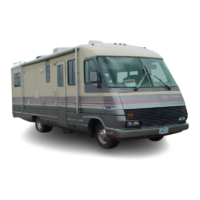ELECTRICAL
SYStEMS
The electrical systems in your
motor
home are
designed and
built
in accordance
with
all regulations,
codes, and standards in
effect
at
the
time
the
motor
home
was built.
CHASSIS
ELECTRICAL SYSTEM
This is
the
vehicle electrical system.
It
includes the
vehicle battery, charging system, ignition system,
cockpit
controls
and instruments,
cockpit
heater/air
conditioner, and
the
headlights, taillights, turn signals,
and
other
vehicle lights and accessories. .
Chassis
Bulbs
&
Fuses
Replace bulbs
with
equivalent
types
as
marked on
the
bulb.
Fuses
for
the
chassis electrical system are located
on a covered panel
under
the
engine
compartment
cover on
the
front
of
the firewall. Others may be found
in
the
12-volt
power
leads
of
the
related
equipment
and accessories.
12-VOLT
COACH
SYSTEM
All 12-volt lighting fixtures and convenience outlets,
12-volt powered vents, fans, motors, and 12-volt
accessories are included in this system. The fresh
water
pump and any 12-volt entertainment equipment
are
connected
to
this system. The .12-volt
power
source is a pair
of
special deep-cycle, high
capacity
6-volt
lead-acid storage batteries, and also an
AC/DC
converter
when
the
motor
home is plugged into 120V
AC
service. Battery charge is maintained by
the
motor
home
engine alternator,
or
by
the charging
circuit
in-
cluded in
the
converter.
The
converter
is
the
nerve center
of
the
12-volt
DC
(as
well
as
the
120-volt
AC system.) Fuses
for
the
12-volt
DC circuits are located
at
the
converter panel.
Always
replace fuses
with
the
same
type
and
amperage rating.
WARNING:
DO NOT INSTALL 12-VOLT FUSES
WITH
AMPERAGE RATINGS
GREATER
THAN
THAT
SPECIFIED ON FUSEBOX.
The
auxiliary
batteries supply
power
for normal
living-area needs.
Sensing and switching circuits per·
mit
the
vehicle
alternator
to
charge all batteries
as
required and prevent
the
living araa 12-volt
re-
quirements
from
depleting
the
vehicle battery.
NOTE:
All
living area radios and tape decks draw
from
the
auxiliary
battery
supply, and extended
usage
may
discharge
it.
Auxiliary
Battery
The
auxiliary
batteries supply power for normal
living·area needs. Sensing and switChing circuits per·
mit
the
vehicle alternator
to
charge all batteries
as
required
and
prevent
the
living
area
12·volt
requirements
from
depleting the vehicle battery.
27
NOTE:
All living area radios and tape decks
draw
from
the'
vehicle battery,
and
extended
usage
may discharge
it.
Battery condition can be checked
on
the
Manito
Panel.
To
check
the
battery
charge:
1.
Unplug
the
120-volt
AC
power
cord
to
turn
thE
'power
converter
off.
2.
Press "BATTERY" rocker
switch
on
the
panel.
3. Turn on a
light
or
any
12-volt
appliance. The bat-
tery
must
be checked
with
a load.
4. Read battery condition on
the
meter.
Battery
Inspection
and
Care
WARNING: ,DISCONNECT THE 120-VOLT ELEC-
TRIC CORD
AND
THE POSITIVE
TERMINAL
'FROM,THEMOTOR
HOME
BATTERY BEFORE
WORKING ON
EITHER ELECTRICAL SYSTEM.
WARNING: REMOVE RINGS, METAL WATCH-
BANDS,
AND
OTHER
METAL JEWELRY BEFORE
WORKING AROUND
A
BATTERY.
USE CAUTION
WHEN USING METAL TOOLS. IF THE TOOL
CONTACTS
THE POSITIVE BATTERY TERMINAL
OR
METAL CONNECTED TO IT, A
SHORT
CIR-
CUIT COULD OCCUR
WHICH
COULD CAUSE
PERSONAL INJURY
OR
FIRE.
WARNING: DO NOT
ALLOW
BATTERY ELEC-
TROLYTE
TO
CONTACT
SKIN,
EYES, FABRICS,
OR PAINTED SURFACES.
THE ELECTROLYTE IS
A SULFURIC ACID SOLUTION
WHICH
COULD
CAUSE SERIOUS
PERSONAUNJURY
OR PRO-
PERTY
DAMAGE. WEAR EYE PROTECTION
WHEN WORKING WITH BATTERIES.
Check the external
condition
of
the
battery
periodically. Look
for
cracks in
the
cover
and case.
Check the vent plugs. Replace
them
if
they
are crack-
ed
or
broken. Keep
thtl
battery
glean.
Accumuletions
,
of
acid film and
dirt
may
permit
'current
to
flow
bet-
ween the terminals and discharge
the
battery.
To
clean
the
battery, wash
it
with
a
diluted
solution
of
baking
soda and
water
to
neutralize
any
acid present,
then
flush
with
clean water. Acid foaming around terminals
or on
top
of
the
battery
is
normal
acid
neutralization.
Avoid 'getting the soda solution
in
the
battery.
Be
sure
the
vent caps
are
tight. Dry
the
cableS
and
terminals.
Don't
use grease
on'the
bare
metal
inside
'the cable
terminals to prevent corrosion. Grease
is
an
insulator.
Electricity will
not
flow
through
it. A
plastic
ignition
spray will protect
the
terminals
after
you have clean-
ed
and reinstalled them.
Check the battery often. Keep the carrier and
hold-
down
hardware clean and free
of
corrosion
and
chemical accumulation.
Battery
Charging
Normally the battery will
be
kept charged by either

